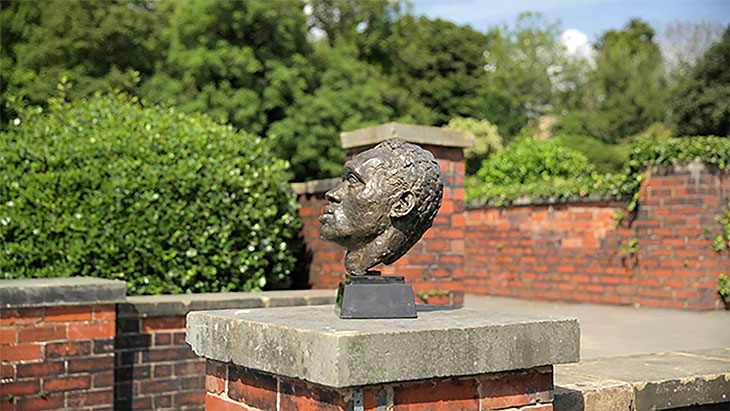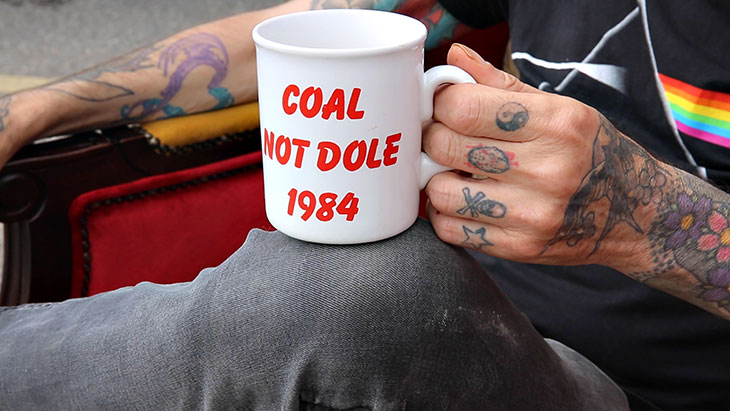A former social worker, Helen Cammock took up studies at the Royal College of Art at the age of 35. In 2019 she won the Turner Prize along with the three other nominees for the award that year – they split the prize money equally. Her work across various media, from film and photography to performance, focuses on particular moments in social history, with an emphasis on the stories of those who have been ignored or silenced. ‘Helen Cammock: Concrete Feathers and Porcelain Tacks’ at the Photographers’ Gallery takes as its starting point the Rochdale Principles of 1844, a set of ideals for how co-operatives should operate (15 October–13 February 2022); a concurrent display will be on view at Touchstones in Rochdale.
Where is your studio?
I have a SPACE studio in Bow, in London. It’s a shared studio with two other artists. I also have a studio of my own at Phoenix Art Space in Brighton.
What do you like most about the space?
In London it is a quiet and containing space, shared with artists whom I can both talk to and sit alongside in silence when working… it has seagulls that walk on the roof, air-con and heating – all very important. In Brighton my space is also quiet – it’s small and has a place to lie down and read, and an oversized desk that takes up too much space but enables me to sketch and draw as well as film edit.
What frustrates you about it?
I would like to have one large space of my own, to be able to do everything in. But studios are hard to come by.

Still from Concrete Feathers and Porcelain Tacks (2021), Helen Cammock. Courtesy the artist; © Helen Cammock
Do you work alone?
It depends what I’m doing. If I’m planning workshops on projects I work with someone who assists in London – but in my Brighton studio I work alone.
How messy is your studio?
Actually, never as messy as the small study in my house.
What does it smell like?
Sometimes dusty, sometimes of paper, or inks, or of the plant materials that the other artist in London is drying or pressing. Sometimes in my corner the smell is of a rotten bin or cups that need a wash, or coffee when someone comes for a studio visit (I don’t drink coffee). But both studios certainly have their own smell.
Which artistic tool could you least do without?
My brain and my camera – that’s two, but they are really important.

Still from Concrete Feathers and Porcelain Tacks (2021), Helen Cammock. Courtesy the artist; © Helen Cammock
What’s the most well-thumbed book in your studio?
It’s probably Your Silence Will Not Protect You by Audre Lorde [posthumously published in 2017].
Do you cook in the studio?
No, I buy a sandwich when I’m really hungry and I eat crisps and biscuits. If I am left to my own devices it’s not the most healthy of eating spaces. But sometimes I’m lucky and my partner makes me an amazing salad.
What do you listen to while you’re working?
Nothing: I like to be in the quiet.
What do you usually wear while you’re working?
What I would usually wear.
Who’s the most interesting visitor you’ve had to your studio?
Etta, my Bedlington-whippet puppy.
Is anything (or anyone) banned?
No, nothing is banned. It is hopefully an open space – a place for dialogue, for thought, for laughter, for planning. There is political discussion of course but it is also a safe space.
‘Helen Cammock: Concrete Feathers and Porcelain Tacks’ is at the Photographers’ Gallery, London, until 13 February 2022.














![Masterpiece [Re]discovery 2022. Photo: Ben Fisher Photography, courtesy of Masterpiece London](http://zephr.apollo-magazine.com/wp-content/uploads/2022/07/MPL2022_4263.jpg)
‘Like landscape, his objects seem to breathe’: Gordon Baldwin (1932–2025)